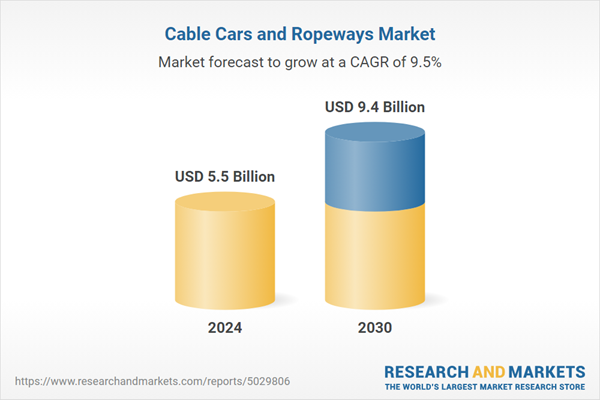The global market for Cable Cars and Ropeways was valued at US$5.5 Billion in 2024 and is projected to reach US$9.4 Billion by 2030, growing at a CAGR of 9.5% from 2024 to 2030. This comprehensive report provides an in-depth analysis of market trends, drivers, and forecasts, helping you make informed business decisions. The report includes the most recent global tariff developments and how they impact the Cable Cars and Ropeways market.
Segments: Product Type (Gondola, Chairlifts, Aerial Tramways, Other Product Types); End-Use (Tourism, Public Transportation, Material Handling).
Geographic Regions/Countries: World; United States; Canada; Japan; China; Europe (France; Germany; Italy; United Kingdom; Spain; Russia; and Rest of Europe); Asia-Pacific (Australia; India; South Korea; and Rest of Asia-Pacific); Latin America (Argentina; Brazil; Mexico; and Rest of Latin America); Middle East (Iran; Israel; Saudi Arabia; United Arab Emirates; and Rest of Middle East); and Africa.
The analysts continuously track trade developments worldwide, drawing insights from leading global economists and over 200 industry and policy institutions, including think tanks, trade organizations, and national economic advisory bodies. This intelligence is integrated into forecasting models to provide timely, data-driven analysis of emerging risks and opportunities.
Global Cable Cars and Ropeways Market - Key Trends and Drivers Summarized
How Are Cable Cars and Ropeways
Revolutionizing Transportation and Tourism?
Cable cars and ropeways are transportation systems that use cables, ropes, or wires to move passengers or goods over various terrains, often in difficult-to-reach areas such as mountainous regions, across rivers, or between urban areas with significant elevation differences. These systems typically consist of cabins or gondolas that are suspended and propelled by a continuous loop of cable or wire. What sets cable cars and ropeways apart from other transportation methods is their ability to navigate challenging geographical landscapes where roads or railways would be impractical or expensive to build. Initially, cable cars and ropeways were primarily used in industrial settings, such as in mining and agriculture, where they transported goods over rugged terrain. However, today they serve a crucial role in both public transport systems and tourism. In urban areas, cable cars help alleviate traffic congestion and provide an efficient, eco-friendly means of transportation, while in tourist destinations, they offer a unique way to explore scenic landscapes, often providing panoramic views that can’t be experienced by any other means. As a result, these systems have become essential not only for their practical transport utility but also for their contribution to tourism and local economies.How Do Cable Cars and Ropeways Benefit Diverse Sectors?
Cable cars and ropeways are increasingly being adopted in a wide range of sectors, with their applications expanding far beyond their traditional uses. In tourism, they are a key feature in many scenic destinations, allowing visitors to access otherwise unreachable viewpoints or attractions. Examples can be found in iconic tourist sites like the Alps in Switzerland, Table Mountain in South Africa, or the Sugarloaf Mountain in Brazil, where cable car systems offer visitors breathtaking views while providing safe and efficient transportation. They are also critical in ski resorts worldwide, where they are the primary means of transporting skiers and snowboarders up mountain slopes. However, their utility goes beyond tourism. In urban environments, particularly in densely populated cities or areas with steep topographies, such as Medellin in Colombia or La Paz in Bolivia, cable cars and ropeways have become an integral part of public transportation networks. These systems help reduce traffic congestion, shorten travel times, and connect neighborhoods that were previously difficult to access due to natural barriers or poor infrastructure. Additionally, in rural and remote areas, especially in developing countries, ropeways are increasingly used for transporting goods and agricultural products across challenging landscapes, significantly reducing travel time and improving local economies. Their versatility across such diverse sectors highlights the vital role they play in addressing both transportation challenges and enhancing tourism experiences.What Are the Technological Innovations Driving Cable Cars and Ropeways?
The technological advancements in cable cars and ropeways have significantly improved their efficiency, safety, and environmental sustainability, making them more appealing as both public transport systems and tourist attractions. One of the most important innovations is the development of detachable cable systems, which allow gondolas or cabins to be disconnected from the moving cable when they arrive at stations. This enables passengers to board and disembark safely without the system needing to slow down or stop, significantly increasing the capacity and efficiency of the system. Moreover, advances in materials science have led to the creation of lighter, more durable cabins and cables, which can carry heavier loads over greater distances while minimizing energy consumption. Modern systems are now also equipped with state-of-the-art safety features, such as automated braking systems, weather monitoring technologies, and wind-resistant designs, which ensure reliable operation even in challenging environmental conditions. In terms of energy efficiency, many cable car and ropeway systems are now powered by renewable energy sources, such as solar or wind power, reducing their carbon footprint and aligning with global efforts toward more sustainable urban mobility solutions. Smart technologies have also made their way into these systems, with the integration of IoT (Internet of Things) sensors that allow real-time monitoring and maintenance, ensuring optimal performance and reducing the likelihood of system failures.What Factors Are Fueling the Expansion of the Cable Cars and Ropeways Market?
The growth in the cable cars and ropeways market is driven by several factors that are tied to evolving technological trends and changing consumer demands. One of the primary drivers is the increasing need for alternative urban transportation solutions. As cities grow more congested and pollution levels rise, governments and city planners are increasingly turning to eco-friendly transport systems, such as cable cars, to reduce traffic congestion and carbon emissions. Cities in mountainous or densely populated areas are particularly inclined to adopt these systems, as they provide an efficient means of overcoming natural barriers while requiring significantly less infrastructure compared to roads or railways. Another significant driver is the growth of the global tourism industry, especially in areas with challenging landscapes where cable cars offer tourists unique experiences by providing access to stunning vistas and remote attractions. With tourism becoming a key economic driver for many countries, investments in new cable car systems at tourist destinations are increasing. Additionally, the rising demand for adventure tourism, such as ziplining or high-altitude trekking, has further fueled interest in cable car projects. In rural and remote areas, particularly in developing countries, cable cars and ropeways are being used to improve accessibility and transport goods, which contribute to local economic development by enhancing market connectivity. Finally, technological advancements, including the rise of smart cities and renewable energy adoption, have created a favorable environment for the expansion of these systems. Governments are now more willing to invest in such infrastructure, as these systems not only provide practical transportation solutions but also align with broader environmental sustainability goals.Report Scope
The report analyzes the Cable Cars and Ropeways market, presented in terms of units. The analysis covers the key segments and geographic regions outlined below.Segments: Product Type (Gondola, Chairlifts, Aerial Tramways, Other Product Types); End-Use (Tourism, Public Transportation, Material Handling).
Geographic Regions/Countries: World; United States; Canada; Japan; China; Europe (France; Germany; Italy; United Kingdom; Spain; Russia; and Rest of Europe); Asia-Pacific (Australia; India; South Korea; and Rest of Asia-Pacific); Latin America (Argentina; Brazil; Mexico; and Rest of Latin America); Middle East (Iran; Israel; Saudi Arabia; United Arab Emirates; and Rest of Middle East); and Africa.
Key Insights:
- Market Growth: Understand the significant growth trajectory of the Gondola segment, which is expected to reach US$4.3 Billion by 2030 with a CAGR of a 8.7%. The Chairlifts segment is also set to grow at 10.6% CAGR over the analysis period.
- Regional Analysis: Gain insights into the U.S. market, valued at $1.5 Billion in 2024, and China, forecasted to grow at an impressive 13.3% CAGR to reach $2.1 Billion by 2030. Discover growth trends in other key regions, including Japan, Canada, Germany, and the Asia-Pacific.
Why You Should Buy This Report:
- Detailed Market Analysis: Access a thorough analysis of the Global Cable Cars and Ropeways Market, covering all major geographic regions and market segments.
- Competitive Insights: Get an overview of the competitive landscape, including the market presence of major players across different geographies.
- Future Trends and Drivers: Understand the key trends and drivers shaping the future of the Global Cable Cars and Ropeways Market.
- Actionable Insights: Benefit from actionable insights that can help you identify new revenue opportunities and make strategic business decisions.
Key Questions Answered:
- How is the Global Cable Cars and Ropeways Market expected to evolve by 2030?
- What are the main drivers and restraints affecting the market?
- Which market segments will grow the most over the forecast period?
- How will market shares for different regions and segments change by 2030?
- Who are the leading players in the market, and what are their prospects?
Report Features:
- Comprehensive Market Data: Independent analysis of annual sales and market forecasts in US$ Million from 2024 to 2030.
- In-Depth Regional Analysis: Detailed insights into key markets, including the U.S., China, Japan, Canada, Europe, Asia-Pacific, Latin America, Middle East, and Africa.
- Company Profiles: Coverage of players such as Bartholet Maschinenbau AG, CCM FINOTELLO SRL, Conveyor & Ropeway Services Pvt. Ltd., Damodar Ropeways & Infra Ltd., Doppelmayr Seilbahnen GmbH and more.
- Complimentary Updates: Receive free report updates for one year to keep you informed of the latest market developments.
Some of the 46 companies featured in this Cable Cars and Ropeways market report include:
- Bartholet Maschinenbau AG
- CCM FINOTELLO SRL
- Conveyor & Ropeway Services Pvt. Ltd.
- Damodar Ropeways & Infra Ltd.
- Doppelmayr Seilbahnen GmbH
- Leitner - Poma of America, Inc.
- LEITNER Ropeways
- MND Group
- Nippon Cable Co., Ltd
- POMA
- STM Teleferik
Tariff Impact Analysis: Key Insights for 2025
Global tariff negotiations across 180+ countries are reshaping supply chains, costs, and competitiveness. This report reflects the latest developments as of April 2025 and incorporates forward-looking insights into the market outlook.The analysts continuously track trade developments worldwide, drawing insights from leading global economists and over 200 industry and policy institutions, including think tanks, trade organizations, and national economic advisory bodies. This intelligence is integrated into forecasting models to provide timely, data-driven analysis of emerging risks and opportunities.
What’s Included in This Edition:
- Tariff-adjusted market forecasts by region and segment
- Analysis of cost and supply chain implications by sourcing and trade exposure
- Strategic insights into geographic shifts
Buyers receive a free July 2025 update with:
- Finalized tariff impacts and new trade agreement effects
- Updated projections reflecting global sourcing and cost shifts
- Expanded country-specific coverage across the industry
Table of Contents
I. METHODOLOGYII. EXECUTIVE SUMMARY2. FOCUS ON SELECT PLAYERSIII. MARKET ANALYSISSOUTH KOREAREST OF ASIA-PACIFICARGENTINABRAZILMEXICOREST OF LATIN AMERICAIRANISRAELSAUDI ARABIAUNITED ARAB EMIRATESREST OF MIDDLE EASTIV. COMPETITION
1. MARKET OVERVIEW
3. MARKET TRENDS & DRIVERS
4. GLOBAL MARKET PERSPECTIVE
UNITED STATES
CANADA
JAPAN
CHINA
EUROPE
FRANCE
GERMANY
ITALY
UNITED KINGDOM
SPAIN
RUSSIA
REST OF EUROPE
ASIA-PACIFIC
AUSTRALIA
INDIA
LATIN AMERICA
MIDDLE EAST
AFRICA
Companies Mentioned (Partial List)
A selection of companies mentioned in this report includes, but is not limited to:
- Bartholet Maschinenbau AG
- CCM FINOTELLO SRL
- Conveyor & Ropeway Services Pvt. Ltd.
- Damodar Ropeways & Infra Ltd.
- Doppelmayr Seilbahnen GmbH
- Leitner - Poma of America, Inc.
- LEITNER Ropeways
- MND Group
- Nippon Cable Co., Ltd
- POMA
- STM Teleferik
Table Information
| Report Attribute | Details |
|---|---|
| No. of Pages | 246 |
| Published | April 2025 |
| Forecast Period | 2024 - 2030 |
| Estimated Market Value ( USD | $ 5.5 Billion |
| Forecasted Market Value ( USD | $ 9.4 Billion |
| Compound Annual Growth Rate | 9.5% |
| Regions Covered | Global |









